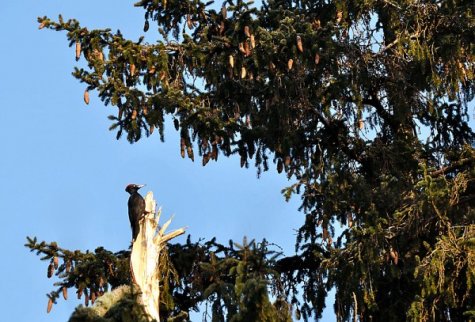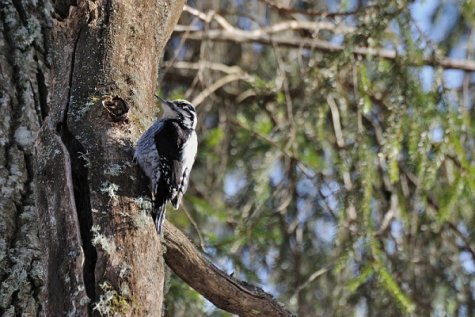Woodpeckers testing drums
Text and photos by Rein Kuresoo, animalcity.eu/kuresoo/
Translation: Liis
Black woodpecker drum – green wood only resounds in cold
Black woodpecker Musträhn Dryocopus martius
Three-toed woodpecker Kolmvarvas or laanerähn Picoides tridactylus
Already from February on the quiet of the forest should be rent by the woodpecker drum. Some noise is to be heard from the woods but mostly the frost cracks here, and the racket of woodpeckers is as yet absent. Despite the fact that the sun is shining brightly and the ever lengthening daylight makes blood play up, the frost chills the ardour of hotheads significantly – who gets too excited can fall down from the tree. Currently heads must still be banged against resounding trees for filling beaks. If the weather were warmer, insects would creep out from inside the trunks to warm themselves in the sunshine, but well, weather is just all an ”if only”. The grubs of the tree-borers are deep inside, to get hold of them the tunnels must be cut out larger, and the long tongue pushed into the cold wood. If you have licked a doorknob in frosty weather you will understand what I have in mind. The tongue of the woodpecker is so long that if the bird would have the idea of hanging itself from a branch, it would not need to look far for a rope. It is amazing that such a thing fits into the beak and does not dangle in the air and interfere during flight.
The root of the woodpecker’s tongue is attached to the joining point of the skull and beak at the right-hand nostril, the tongue then running through the nostril over the forehead and crown, and slipping from behind the nape between the two lower jawbone parts - into the mouth of the woodpecker. The tongue is supported by a reinforcing structure of small bones and cartilage. It is worthwhile to talk at length about the tongue of the woodpecker because for the bird who uses mainly its head for work as well as drumming, it is an indispensable instrument for preserving mental health. The skull being wrapped in the tongue is one of the mechanisms that help the woodpecker to avoid concussion. The force of the blows is damped, in addition to by the tongue, by the strong but elastic beak and the spongy bones in the forehead part of the skull, and other brain and cranium structure details. The woodpecker’s tongue is such a remarkable ”divine” invention that it has merited particular attention from creationists . The fact that the hyoid bone and cartilage, which in humans as well as in most birds are located between the throat and lower jaw, have in a single moment in history jumped from below the throat to above the nose and then circled the head is just as unbelievable as the tale of Lopi and Lapi, where Lapi had a sizzling black pudding sausage grow on her nose because of a simple communication failure. Alas, the devil had once led the famous Charles Darwin astray. Relatively small differences in the beak shape of the Galapagos finches and other such odds and ends had made him believe that evolution is the gradual fixing of tiny changes by natural selection. The pious naturalist Darwin would have been driven into a serious quandary by the mystery of the woodpecker’s tongue; today’s evolutionarists simply don’t bother to discuss these things about the woodpecker’s tongue with creationists.
However that may be with the woodpecker’s tongue, I don’t think that it would be too comfortable in a frost to keep the tongue for very long in a cold tree. The woodpeckers are somehow silent and I am inclined to suspect that they must be busy for a large part of the day with warming up the tongue – or with sitting still, tongue in mouth. But it isn’t actually quite as morose as in winter. When an insect has been sent into the belly and the tongue has been warmed up, one must test, even if just a little, how well the forest drums boom.
The three-toed woodpecker inhabits spruce forests but often prefers deciduous trees as drums. This is an oak djembe










